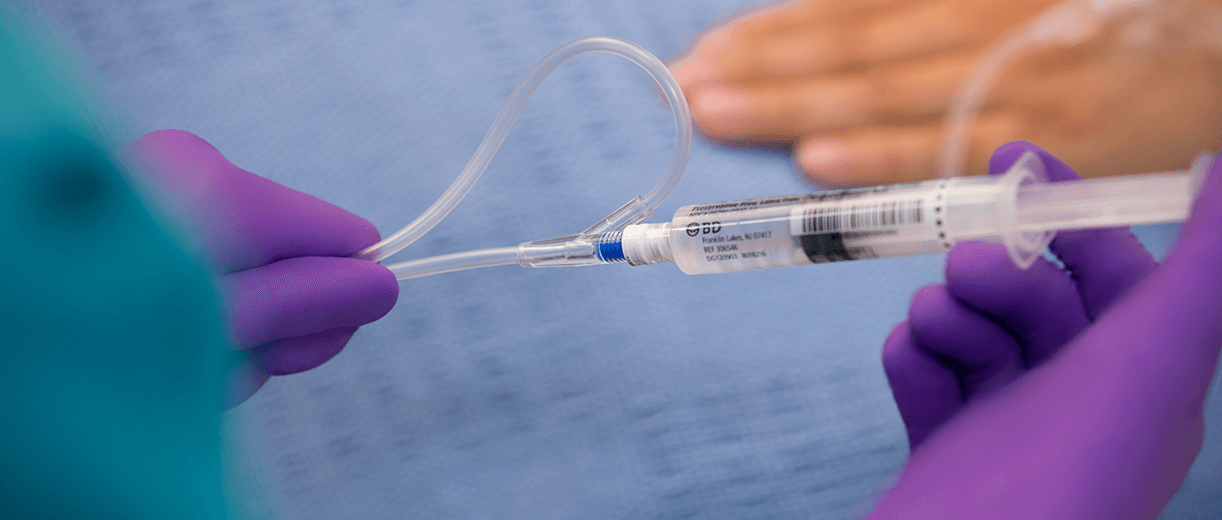7 reasons to add pre-filled syringes to your vascular access practice
IV catheter-related complications impact patient care
60–90% of hospitalised inpatients require an intravenous (IV) catheter1, out of which, up to 50% of peripheral IV catheters (PIVCs) don’t reach their intended dwell time and will need to be replaced prematurely1. Catheter failure may result from variation in practice1.
IV catheter-related complications can increase pain and discomfort for the patient1,2. These complications may also have an impact on healthcare professionals (HCPs) like yourself. Your workflows may be disrupted, leading to potentially reduced efficiency1.
Periodically flushing vascular access devices (VADs) with a saline solution has been proven to be an effective infection prevention measure in IV therapy3. Compared with manually prepared flushing syringes, pre-filled saline syringes require less manipulation, which could help reduce contamination2.
The following are seven important practice guidelines you can follow to ensure proper flushing technique.
1. Know when to flush
Before infusion, flush and aspirate VADs to evaluate catheter patency and prevent possible complications4. After infusion, make sure to flush VADs to clear out any residual medication from the catheter lumen4. This can reduce the risk of interaction between incompatible medications4.
2. Determine the flush volume
To properly maintain catheter patency and reduce medication interactions, keep the following factors in mind when selecting the proper flush volume4:
- Catheter type
- Catheter size
- Patient age
- Infusion therapy type
- Patient condition
Recommendation: When infusing blood components, parenteral nutrition, contrast media, or other viscous solutions, you may need to use higher flush volumes4.
3. Disinfect connections before flushing4
Infusion Nurses Society 2021 guidelines recommend using a passive disinfecting cap containing 70% isopropyl alcohol to create a physical barrier to contamination between uses4.
4. Use a single dose of preservative-free 0.9% sodium chloride (e.g., pre-filled labelled syringes)4
Multiple doses are not recommended because they could disrupt aseptic technique and lead to potential contamination or cross contamination3. Single-dose pre-filled saline syringes may minimise the risk of IV complications such as catheter contamination5.
5. Practice a pulsatile flushing technique
When compared with continuous low-flow techniques, alternating between 10 short boluses of 1-mL saline solution and brief pauses may be more effective at rinsing solid deposits from the VAD4.
6. Lock the VAD lumen
After completing the flush, make sure to lock the VAD lumen to minimise the risk of intraluminal occlusion and catheter-related bloodstream infections (CRBSIs)4.
7.Follow the instructions6*
- Open pack and remove syringe
- Check that syringe tip cap is in place. Inspect clarity of solution
- Depress plunger with tip cap on to release the stopper seal
- Unscrew tip cap from the syringe ensuring that there is no touch contamination of the syringe luer connection
- Push syringe plunger to expel the air
- Connect syringe to vascular access device, taking care that there is no touch contamination of the connection
- Push syringe plunger to flush the required volume of saline following your institution’s policy
- After use, dispose of in accordance with recognised procedure at your institution
- Do not re-use
Add pre-filled syringes to your vascular access practice
By making pre-filled saline syringes part of your vascular access practice and using them correctly, you can help reduce PIVC failure rates and prolong catheter dwell times3.
The BD PosiFlush™ Pre-filled Saline Syringe contains a sterile 0.9% sodium chloride solution used to flush in-situ VADs. It comes in three volumes (3 mL, 5 mL and 10 mL) of equal diameter (10 mL syringe).
Because the BD PosiFlush™ 3-mL Syringe has the same diameter as a standard 10-mL syringe, it generates less pressure than smaller diameter syringes and reduces the risk of catheter damage7.
BD PosiFlush™ Pre-filled Saline Syringe belongs to an integrated approach to vascular access care. From patient assessment to device removal, one of the objectives of vascular access management is to enable HCPs to help reduce IV catheter-related complications.
*These instructions only apply to BD PosiFlush™ Pre-filled Saline Syringes.
References
- Helm RE, Klausner JD, Klemperer JD, Flint LM, Huang E. Accepted but unacceptable: peripheral IV catheter failure. J Infus Nurs Off Publ Infus Nurses Soc. 2015;38(3):189-203. doi:10.1097/NAN.0000000000000100
- Keogh S, Marsh N, Higgins N, Davies K, Rickard C. A time and motion study of peripheral venous catheter flushing practice using eded and prefilled flush syringes. J Infus Nurs Off Publ Infus Nurses Soc. 2014;37(2):96-101. doi:10.1097/NAN.0000000000000024
- Saliba P, Cuervo G, Hornero A, et al. The impact of flushing with pre-filled saline syringes on the incidence of peripheral venous catheter failure: A quasi-experimental study. J Vasc Access. 2019;21(4):490-496. doi:10.1177/1129729819888423
- Gorski LA, Hadaway L, Hagle ME, et al. Infusion Therapy Standards of Practice, 8th Edition. J Infus Nurs Off Publ Infus Nurses Soc. 2021;44(1S Suppl 1):S1-S224. doi:10.1097/NAN.0000000000000396
- Sacha G, Rogers JA, Miller RL. Pre-filled syringes: a review of the history, manufacturing and challenges. Pharm Dev Technol. 2015;20(1):1-11. doi:10.3109/10837450.2014.982825
- BD PosiFlushTM SP Pre-Filled Saline Syringe Instructions For Use.; 2020.
- Start K. Prefilled saline flushes. Hospital Pharmacy Europe. Published on 18 August 2010. Accessed on 17 May 2022, at
https://hospitalpharmacyeurope.com/news/editors-pick/prefilled-saline-flushes/


BD-61472




